St Stephen's Walbrook, and its sculptural interest
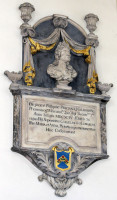
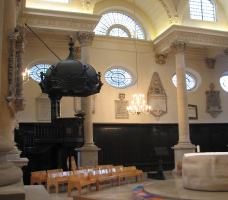
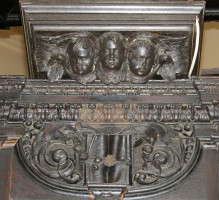
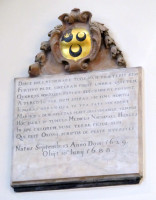
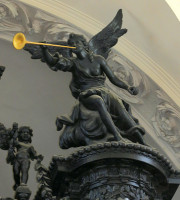
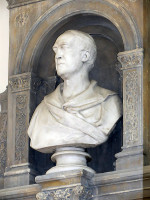
The City Church of St Stephen Walbrook, just a couple of minutes walk from both Bank and Cannon Street tube
stations, is considered one of Christopher Wren’s masterpieces. It sustained some but not irrecoverable war damage
and was restored, and many of the monuments and furnishings survived.
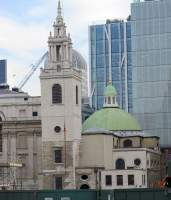 St Stephen Walbrook, from Queen Victoria Street.
St Stephen Walbrook, from Queen Victoria Street.
Wren’s building replaced a 15th Century edifice destroyed in the Great Fire, and was
put up between 1672-79. The steeple dates from 1713. Currently a good view, above, can be obtained of the exterior from
Queen Victoria Street, due to a building site. The exterior has tall, flat walls, small rectangular, and
Roman-style windows, and round upper windows. The two features are the steeple and the dome, but it is inside that
the architecture comes into its own.
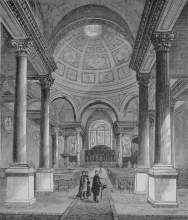
The church floor is at some height above the ground outside, hence we must climb up some steps to enter. The
interior is rectangular, with four lines of Corinthian pillars topped by round arches which support the dome in a
complex and elegant geometric pattern. Pairs of columns are absent from the centremost lines, to make a central space and
give almost a Greek cross shape, rather Byzantine in effect. Apparently this method of supporting a dome was Wren's
prototype for his St Paul’s Cathedral design. The dome is decorated with
compartments filled with repeating flowers and fronds, and small
supports to the main struts have carved winged cherub heads and shells etc. The interior, seen in our picture above,
is in white and pale colours with gilding, and the windows seem larger and more numerous than from the outside,
making the interior bright and spacious. This contrasts with the dark wooden panelling forming a band around the interior up to
door height, and the equally dark altar, of greater height, has cherubic and fructifying carving and paintings of
Moses and Aaron, as once sported by many Wren churches. The carved stone font, with
drapery and cherubs’ heads around the rim, has a very ornate wooden cover with twisted columns, between which are
little oval panels with cherubs, and above, free standing female figures surround a central ogee dome bearing a crown.
From the time of Wren, but charmingly medieval in spirit. The pulpit, of some size, with a top heavy looking
cover above supported on a single pillar, bears half a dozen small carved cherubs holding garlands of flowers
between them. Approaching this, we can look back towards where we came in, to see the vast organ, forming a
composite with the heavy dark entrance, with pillars and garlands, coat of arms and cherubic heads, going up to
the top of the highest arch where a pair of trumpeting angels sit. Again, all from the time of Wren - see pictures at the
top of this page, and as usual, click to enlarge.
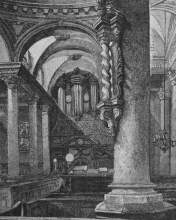 View of interior showing side of Robert Marriott memorial on the pillar, and the organ.
View of interior showing side of Robert Marriott memorial on the pillar, and the organ.
And now to the monuments, the primary concern of these pages. John Stow, visiting the pre-Fire Church,
wrote that 'There bee monumentes in thechurch of Thomas Southwell first Parson of this new church,
who lyeth in the QUier, John Dustable [see 20th Century memorials below]...Sir Richard Lee Mayor, ...
Rowland Hill Mayor, 1549, Sir Thomas Pope first Treasurer of the augmentations, with his wife Dame Margaret,
Sir John Cootes Mayor, 1542. Sir John Yorke Knight, Marchaunt Taylor, 1549. Edward Jackman Shiriffe, 1564,
Richarde Achley, Grocer, Doctor Owyn, Phisition [physician] to king Henrie the Eight, John Kirkbie Grocer, 1578, and others.'
Alas, all of these perished. However, in the Wren Church we do have a good crop of monuments of sculptural interest,
including a couple of busts and several plaques of elaborate form, and two 17th Century pillar cartouches. As usual, we consider
these in more or less date order:
17th Century Monuments:
- John Lilburne, d.1678, citizen and grocer, of the Lilburn family of Sunderland,
and his wife Isabella. The earliest monument in the Church, and certainly very sculptural.
It is a pillar monument, that is to say a plaque which is curved to better fit to a pillar in the Church.
The Latin inscription is in a delicate oval wreath of linked flowers or buds, with to left and right
little standing figures of the couple, he with cloak and long flowing hair above a tunic, with big cuffs
and slender shoes, she a slender wasted figure with long, flaring skirt, puffed out bodice and again drapes
over and behind her head. A charming pose with her arms crossed in front of her. Below, winged cherubic heads
and a knotted fabric, above, a flanking pair of particularly horrible cherubs, one apparently sucking on some stick,
with between them a high relief sculpture of a woman dancing with Death, who is a skeleton wearing a long skirt,
above a festoon of flowers. On top of the whole, a coat of arms with large acanthus leaf surround, and little helmet.
All in white marble; a skilfully executed and inventive monument.
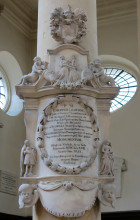
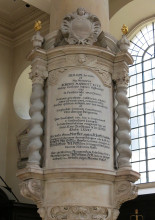 Lilburne and Marriott memorials, late 17th Century.
Lilburne and Marriott memorials, late 17th Century.
- Nathaniel Hodges, d.1688, simple square with above, a small painted cartouche of arms
with string of flowers on each side. He was a hero of the 1665 plague, but died in a debtor’s prison. See picture at top of page, 4th along.
- Robert Marriott, d.1689. Another pillar monument, the companion piece to the Lilburne monument
noted above, with Latin inscription on a curved slab with flowers filling the top corners,
the whole between two twisted pillars which form the focus of the monument.
The inscribed panel is surmounted by an entablature with a winged cherubic head,
above which is a cartouche with a worn low relief coat of arms with another cherubic head above,
all this being in the middle of a broken, curved pediment, with two vases with gilded flames flanking,
above the pillars. Beneath, the twisted pillars stand on scrolly borackets, with a blank apron in between,
beneath which is a base carved with scrolls and flowers. The monument is made in pale stone, and is very baroque.
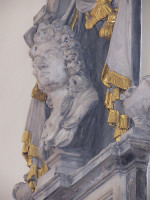
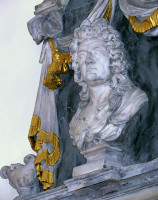
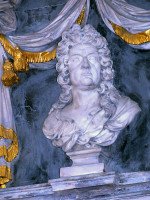
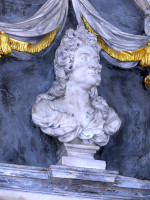
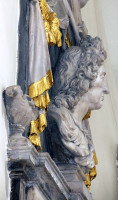
Views of the bust of Percival Gilbourne, d.1694.
- Percival Gilbourne, d.1694, with a short Latin inscription on a panel
with a colourful marble surround. This is the first of our portrait busts: we see a noble bewigged head
of an ageing man, firm of countenance and strong of neck, but with something of a jowl, above shoulders
and chest wearing a drape rather than contemporary clothing. The bust (see pictures above, and at top of page) is sounded by hanging drapes,
elegantly and confidently rendered, tied at the top and sides, and then hanging freely, with gilded fringes.
Behind is a black arched backing, with small pots on the sides, and below, lamps. At the base of the monument
is an apron with painted shield of arms, crossed fronds, and a nicely carved corbel at the base.
- Hannah Browne, d.1693, husband Daniel Browne, d.1706,
'Skynner to all the kings and queens of this realm from 1660', their daughter Jane, d.1696,
her husband Dixcy Kent, and son Daniel Browne, d.1698 with a sad inscription.
The panel, tightly written, is in a rectangular frame, and above is a cartouche bearing a painted coat of arms.
18th Century Monuments:
- Sir Samuel Moyer, Baronet, d.1716, with a long, rather touching inscription. Pale stone,
inscription on a carved hanging with drop folds to left and right, held by two cherubs, one blowing a trumpet,
and both holding up the drapes. There are carved flowers at the lower corners, and the whole sits on a
protruding shelf, below which is an apron with a painted coat of arms in a cartouche.
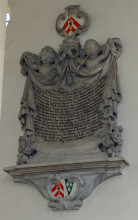
 Early 18th Century tablets: Sir Samuel Moyer and Samuel Hayward.
Early 18th Century tablets: Sir Samuel Moyer and Samuel Hayward.
- Samuel Hayward, d.1722, ‘a very Loyal and Peaceful Member of the Common Wealth,
and a very useful Citizen’, and wife Mary, d.1729, and son William, d.1731.
Heavy pale panel with square pilasters to the sides, with oversized capitals, and at the top,
a shield of arms with a baroque surrounding cartouche, but no pediment at all.
At the base, two large curled brackets, with blank panel in between, and beneath that,
a smaller apron with carved drapery.
- Scrimshire, John, d.1768, Merchant, and sister Elizabeth, d.1779,
a rectangular panel with brecciated marble classical surround, including an empty pediment above,
and on top of that, a carved cartouche with painted arms.
- Arthur Beardmore, d.1771[?], white panel with shaped coloured marble inset and surround,
including curved pilasters and a pediment enclosing a now black oval and two festoons.
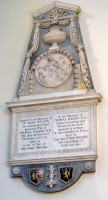
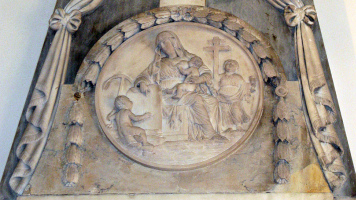 Mary Wilson, d.1772, by the sculptor J. F. Moore.
Mary Wilson, d.1772, by the sculptor J. F. Moore.
- Mary Wilson, d.1772, and husband Thomas, d. 1784,
rector and only son of Thomas Wilson, Lord Bishop of Sodor and Man, double inscription underneath roundel
with relief sculpture of female figure and two infants, one suckling, the other holding an anchor,
and a worn figure of woman with tall cross and bell behind. Pot above, and nicely tied drapery festooned around,
all on a dark somewhat pyramidal backing. Below, on the grey marble apron, two coats of arms.
. This is the work of the sculptor John Francis Moore, most familiar from his grand monument to William Beckford,
Lord Mayor of London, in the Guildhall. His panel to Faith Sawrey in Bradford Cathedral is illustrated
on this page.
- Deschamps family, d.1720s to 1776, and through to 1840s,
pale stone panel with surmounting Baroque panel bearing armorial shield, little pots around,
winged cherub head below, all on purplish brecciated marble rising to an obelisk. Effectively decorative, this is
an example of the work of a rather obscure sculptor-mason called Oliver Sanders.
- Robert Royds, Merchant, d.1780, panel on coloured marble with coat of arms and fronds,
gilded fire crucibles, funereal urn above. A good, solid monument close to the end of the period
when coloured marbles featured on such monuments.
- George Street, d.1786, and Sarah his wife, d.1791,
white panel with mantelpiece shelf above, dark slatey pyramid above and behind,
with a white Greek pot in high relief, sporting a drape.
- Martha Townley d.1796, Martha Townley . 1824, G.S. Townley d.1825,
father and husband respectively of the others, 50 years rector of parish, simple panel with little feet
and at the top a cut out somewhat like a very shallow pediment..
- Prime, Jane, d.1797 and husband Richard, d.1804, and eldest daughter
Mary Airey d.1835, simple white panel on black, shaped like end of sarcophagus with three tiny flowers.
Signed indistinctly, perhaps by Elmes.
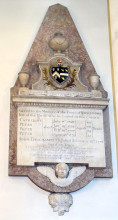
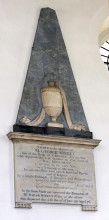 18th Century obelisk monuments: Deschamps family, and George Street.
18th Century obelisk monuments: Deschamps family, and George Street.
19th Century Monuments:
- George Griffin Stonestreet, d.1802, MD of Phoenix and Pelican Companies,
erected by proprietors of those two offices. This white marble monument is centred on a worn, high relief figure
of a young, fair woman leaning on a pot, holding a scroll in her free hand.
The Pelican feeding her young is carved on the plinth above, a tiny fire engine is bottom right,
ship and parcels to the left, and above all is a pot with winged cherub head handles, wreath of flowers,
and at its top, a phoenix, thus covering both institutions. The monument is signed by
the highly accomplished sculptor John Bacon Junior, and dated 1803.
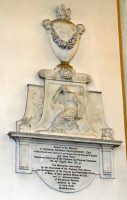
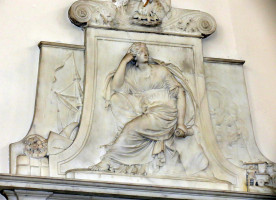 G.G. Stonestreet, d.1802, by the sculptor John Bacon Jr.
G.G. Stonestreet, d.1802, by the sculptor John Bacon Jr.
- Edward Pryce, d.1807, and wife Hester, d.1823, and brother Thomas,
d.1800. Simple white panel on dark backing with a bit of ornament and a painted red lion logo. The monument is a minor work by John Malcott Jr,
who signed monuments at St Martin’s Ludgate
and St Magnus the Martyr, as well as several other works outside London.
- Samuel Brandram, d.1808, merchant, and wife Jane, d.1812,
a simple panel with two lions heads, two pots in relief, brass wreath, all very humble.
- Benjamin Winthrop, d.1809, Merchant, a Director and Governor of the Bank of England, and parents,
plain white panel.
- Benjamin Winthrop, d.1847, eldest son of Benjamin Winthrop, barrister.
A simple white marble tablet with shelf, styled as a tomb chest end, on a shaped black backing.
- George Alfred Croly, d.1845, eldest son of the Revd. George Croly, below.
He was a lieutenant in the Bengal Light Infantry, fought in Cabul, and ‘fell gloriously by a cannon shot in the
Battle of Ferozeshushur, in the assault on the entrenched camp of the Sikhs’.
An example of a Gothic monument, styled as a window with crocketing at the top and narrow,
clustered attached pillars at the sides. The panel incorporates low reliefs of two medals,
labelled Cabul [Kabul] and Sutlej.
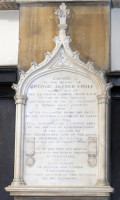 Gothic memorial to George Alfred Croly, d.1845.
Gothic memorial to George Alfred Croly, d.1845.
- Revd George Croly, d.1860, and wife Margaret Helen, d.1851, and daughter
Helen Louisa Mary, d.1851. One of two inscribed panels, the parallel one noting the bust above,
given by his parishioners and bequeathed by him to the Church, and painted windows now gone.
The bust is atop a pillar dividing the two inscriptions, in a niche under a round-topped arch with minor high relief
floral adornments. Grey-beige stone, the bust and inscriptions in white marble. The bust is an accomplished,
highly finished piece, showing Revd. Croly in later middle age, wearing a cloak suggesting Roman costume;
indeed, the whole tone of the bust is of a noble Roman, and the arch above is severely Romanesque.
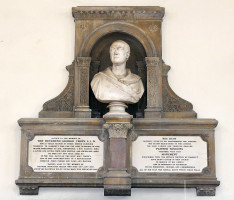 Revd. Goerge Croly, d.1860. In the style of a noble Roman.
Revd. Goerge Croly, d.1860. In the style of a noble Roman.
- Henry Rock and Prudence, his wife, and family of Barnstaple, Devon,
with half a dozen of the family, who died in the 1860s onwards. A simple stone panel with flanking pilasters
and a pediment containing some worn design with a bird, on a black back-panel, signed by the mason, W. J. Gleaves.
- William Windle, d.1899, Rector of the Church, a simple panel with curly pediment and shield
and scrolling above, with perhaps a deer’s head and antlers.
20th Century Monuments:
Alas, we have no monument to Sir John Vanbrugh, the famous architect buried in the church.
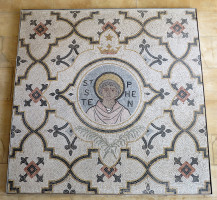 Mosaic panel of St Stephen.
Mosaic panel of St Stephen.
Before concluding, we should note the large panel mosaic to St Stephen hanging next to the stair in the
entrance vestibule. It shows a geometrical design in black, beige, grey-blue and two terra cottas on a white ground,
with a central roundel showing the saint, with halo and simple drapes. It is hard to know what to make of this –
the laying of the background mosaics is in traditional Roman style, while the face is anything but,
and the background within the roundel is laid in Victorian fashion. I can only guess this is a very modern work done
by several workers or a heavily restored piece from earlier.
With thanks to the Church authorities for permission to use pictures from inside the Church; their website is at
http://ststephenwalbrook.net/history_early.htm.
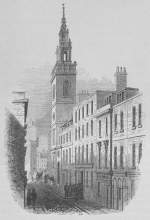 St Stephen's Walbrook in about 1840.
St Stephen's Walbrook in about 1840.
Top of page
Just East to St Mary Woolnoth // North West along Poultry to St Mary le Bow
// North and East along Cornhill
City Churches // Christopher Wren // London sculpture // Sculptors // Introduction to church monuments
Angel statues // Cherub sculpture
Home
Visits to this page from 13 Mar 2014: 144 since 11 November 2025






 St Stephen Walbrook, from Queen Victoria Street.
St Stephen Walbrook, from Queen Victoria Street.
 View of interior showing side of Robert Marriott memorial on the pillar, and the organ.
View of interior showing side of Robert Marriott memorial on the pillar, and the organ.

 Early 18th Century tablets: Sir Samuel Moyer and Samuel Hayward.
Early 18th Century tablets: Sir Samuel Moyer and Samuel Hayward.

 18th Century obelisk monuments: Deschamps family, and George Street.
18th Century obelisk monuments: Deschamps family, and George Street.
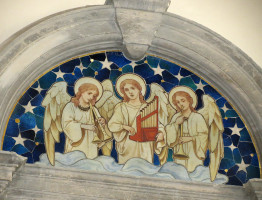 John Dunstable, d.1666, Astronomer and Musician; monument of 1904.
John Dunstable, d.1666, Astronomer and Musician; monument of 1904.
 St Stephen's Walbrook in about 1840.
St Stephen's Walbrook in about 1840.